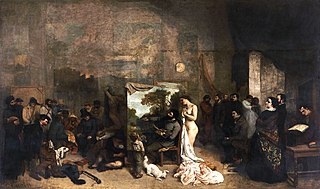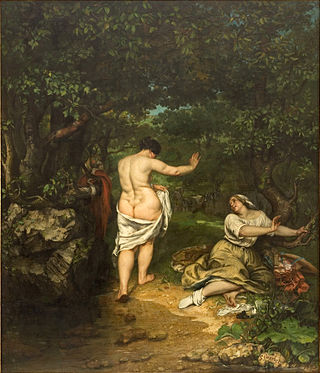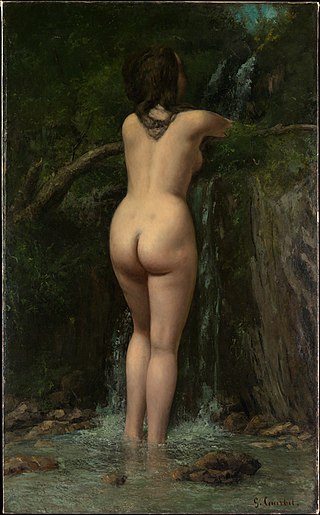
Jean Désiré Gustave Courbet was a French painter who led the Realism movement in 19th-century French painting. Committed to painting only what he could see, he rejected academic convention and the Romanticism of the previous generation of visual artists. His independence set an example that was important to later artists, such as the Impressionists and the Cubists. Courbet occupies an important place in 19th-century French painting as an innovator and as an artist willing to make bold social statements through his work.

The Painter's Studio is an 1855 oil-on-canvas painting by Gustave Courbet. It is located in the Musée d'Orsay in Paris, France.
Three ships of the French Navy have been named Courbet in honour of Amédée Courbet:

Ornans is a commune in the Doubs department in the Bourgogne-Franche-Comté region in eastern France. On 1 January 2016 the former commune Bonnevaux-le-Prieuré was merged into Ornans.

A Burial at Ornans is a painting of 1849–50 by Gustave Courbet. It is widely regarded as a major turning point in 19th-century French art. The painting records a funeral in Courbet's birthplace, the small town of Ornans. It treats an ordinary, provincial funeral with frank realism, and on the grand scale traditionally reserved for the heroic or religious scenes of history painting. Its exhibition at the 1850–51 Paris Salon created an "explosive reaction" and brought Courbet instant fame. It is currently displayed at the Musée d'Orsay in Paris, France

The Wounded Man is an oil-on-canvas self-portrait created between 1844 and 1854 by the French Realist painter Gustave Courbet. In it, Courbet depicts himself in a romantic theme as a suffering, heroic man. Originally, the composition featured a woman leaning on the artist's shoulder. Sometime before May 1854, Courbet replaced her with a sword, and added a red bloodstain on his shirt. Courbet's decision to depict himself as a wounded man may have arisen from his distress at the dissolution, circa 1851, of his 14-year relationship with Virginie Binet, with whom he had a son.

The Meeting or "Bonjour, Monsieur Courbet" is an oil-on-canvas painting by Gustave Courbet, made in 1854. It depicts the artist on his way to Montpellier meeting his patron Alfred Bruyas, his servant Calas and his dog. One of the most emblematic works by the artist, it is also one of his most popular. The composition is based on the myth of the Wandering Jew.

Killing a Deer or A Deer Hunt – The Kill, is a very large painting representing a hunting scene, completed in 1867 by the French Realist painter Gustave Courbet. The picture is currently on display in the Musée des Beaux-Arts et d'Archéologie of Besançon.

The Musée Courbet or Courbet Museum is a museum dedicated to the French painter Gustave Courbet. It is located in Ornans in the Doubs-Franche-Comté area of France.

Realism was an artistic movement that emerged in France in the 1840s, around the 1848 Revolution. Realists rejected Romanticism, which had dominated French literature and art since the early 19th century. Realism revolted against the exotic subject matter and the exaggerated emotionalism and drama of the Romantic movement. Instead, it sought to portray real and typical contemporary people and situations with truth and accuracy, and not avoiding unpleasant or sordid aspects of life. The movement aimed to focus on unidealized subjects and events that were previously rejected in art work. Realist works depicted people of all classes in situations that arise in ordinary life, and often reflected the changes brought by the Industrial and Commercial Revolutions. Realism was primarily concerned with how things appeared to the eye, rather than containing ideal representations of the world. The popularity of such "realistic" works grew with the introduction of photography—a new visual source that created a desire for people to produce representations which look objectively real.
Courbet is a French surname. Notable people with the surname include:

The Bathers is an oil-on-canvas painting by the French artist Gustave Courbet, first exhibited at the Paris Salon of 1853, where it caused a major scandal. It was unanimously attacked by art critics for the large nude woman at its centre and the sketchy landscape background, both against official artistic canons. It was bought for 3000 francs by Courbet's future friend Alfred Bruyas, an art collector – this acquisition allowed the artist to become financially and artistically independent. It is signed and dated in the bottom right hand corner on a small rock. It has been in the musée Fabre in Montpellier since 1868.

Self-Portrait with a Black Dog, Portrait of the Artist or Courbet with a Black Dog is an 1842 oil-on-canvas painting by the French artist Gustave Courbet, retouched by the artist in 1844. It is now in the Petit Palais in Paris.

The Quarry: Deer Hunt in the Forests of the Grand Jura is an 1857 painting by the French artist Gustave Courbet. It was his first work on a hunting theme and is now in the Museum of Fine Arts, Boston.

The Oak at Flagey or The Vercingetorix Oak is an oil-on-canvas landscape painting by the French Realist painter Gustave Courbet, created in 1864, measuring 89 by 110 cm. It shows an oak near the Courbet family farm in the village of Flagey, Doubs, a few kilometres from Ornans in Franche-Comté, named in relation to Vercingetorix. The oak was later struck by lightning and no longer survives. The painting is held at the Musée Courbet, in Paris.

Young Ladies of the Village or The Village Maids is an 1852 oil-on-canvas painting by the French artist Gustave Courbet, now in the Metropolitan Museum of Art, in New York. It is signed bottom left "G. Courbet".

Jo, the Beautiful Irishwoman is the title of a series of four oil on canvas bust-length portraits by Gustave Courbet. They all show the same redheaded Irish model Joanna Hiffernan looking in a mirror – she also modelled for Whistler. The works have minor differences in details and dimensions but their exact chronology is unknown. They are now in the Nationalmuseum, the Metropolitan Museum of Art, the Nelson-Atkins Museum of Art and a private collection.

Proudhon and His Children is an oil-on-canvas group portrait by the French painter Gustave Courbet, created in 1865, now held in the Petit Palais in Paris. The main figure is a posthumously produced image of French philosopher Pierre-Joseph Proudhon, who appears with his two children reading and playing.

The Fishing Boat is an 1865 painting by French painter Gustave Courbet. Done in oil on canvas, the painting depicts a beached fishing boat on the French coastline near Trouville. It is currently in the collection of the Metropolitan Museum of Art, in New York.

The Source is a 1862 oil painting on canvas by the French realist painter Gustave Courbet. The painting shows a nude woman standing outside in nature, in a body of water.

















